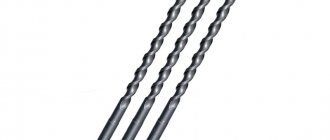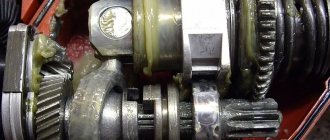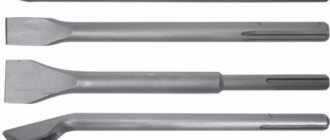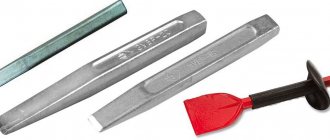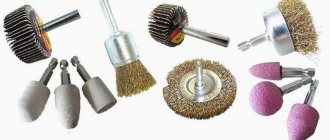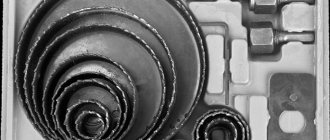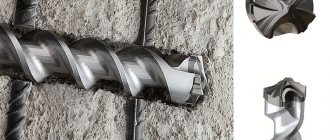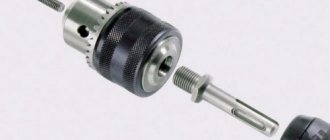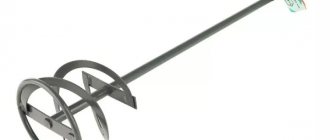Attachments for hammer drills, such as drills, chisels, crowns, picks, and blades, are designed to perform a variety of jobs: scoring, drilling, chiseling. Thanks to their use, the functionality of the device has significantly expanded. Due to the impact function and high-strength, wear-resistant replaceable parts, the tool can be used to work with hard materials. Each type of hammer drill attachment is characterized by its own design features and standard sizes. In addition to the main types offered by retail chains, there are a number of modifications created by craftsmen at home.
Recommendations and tips on how to drill concrete with a drill
Many people wonder what the best drill bits should be used for the job.
Everything depends not only on the attachment and the power tool itself, but also on the correctness of the corresponding manipulations. Features of the use of the devices in question are to comply with the following recommendations: Correct choice of nozzle. This determines not just the ability to drill a hole with a drill, but also the ability to secure a dowel in it. To do this, it is necessary to take into account the diameter as well as the length of the corresponding nozzle
You need to pay attention to the dimensions right away, but it is better to buy a set of drill bits for a drill in a package. Drilling reinforced concrete - in order to make a hole in a wall made of reinforced concrete, it is not necessary to buy a special device with diamond coating. An ordinary pobedit drill is also not capable of coping with this task, since it will heat up and quickly become unusable
However, there is a way out of this situation - when the equipment reaches the metal reinforcement, it is necessary to install a metal drill in the drill chuck and drill through the metal. Once the metal is drilled out, you can continue to use pobedit-tipped tooling
https://youtube.com/watch?v=K5H96PpClxI%3F
- If pobedite-tipped equipment has become dull, it can be restored using a grinder with a diamond-coated wheel
- Avoid overheating of the equipment - if the concrete is very strong, the drilling process can take 10 minutes or more. During this time you need to pause, otherwise the metal of the equipment will quickly heat up and begin to melt. Each subsequent minute of work should be alternated with pauses of 10-15 seconds. It is best to use water cooling by feeding water into the hole being drilled.
- Difficulties with drilling stones - if during the work the nozzle bumps into a stone, then there is a high probability that the drill will not be able to cope with it. To crush stone you will need a more powerful tool - a hammer drill. With its help you can quickly break through a wall and achieve your goal.
- Frequent use of an impact drill for processing concrete surfaces is not recommended. First of all, the tool is not designed for such loads, so if you plan to frequently use the tool with attachments made of pobedite tipped, then it is better to use a hammer drill
- When drilling holes in ceramics, only diamond drills should be used, and the work should be performed in a non-impact mode. This will prevent the destruction of the integrity of the tile, since, despite its high strength, it is a fragile material.
If you take all these recommendations into account, the process of processing concrete using drill equipment will be carried out effectively. Below is a table with recommendations for using concrete drill bits for drills.
| Popular questions | Answers |
| How to drill a concrete wall in an apartment | To do this, it is better to use a hammer drill with a drill. If you don’t have a hammer drill, a drill with a high-quality Pobedit drill bit will do. |
| How to drill through concrete with rebar | Equipment for concrete and metal is used simultaneously. As soon as the device hits the reinforcement, you need to use metal equipment |
| How to choose drills | It is necessary to select according to such basic parameters as nozzle length, thickness or diameter, type of soldering, as well as the design of the tail part |
| Is it possible to drill concrete with a screwdriver? | If a drill can be fixed in a screwdriver chuck, this does not mean that this tool is suitable for processing concrete. Firstly, it does not have a shock function, and secondly, its electric motor is too weak |
| Is it possible to drill through concrete using metal equipment? | This is not possible, since the device will stand in place without making holes. In addition, the equipment will quickly become dull |
https://youtube.com/watch?v=DHbLD4rFdJM%3F
The type of equipment under consideration is intended for use not only in the design of impact drills, but also in a hammer drill. To do this, an adapter for drills is installed in the hammer drill. However, you need to take into account the fact that the drill equipment is not designed for heavy loads, so it is possible that during prolonged use in a hammer drill, it can quickly fail. And it is not recommended to use a screwdriver to drill holes in the wall, as this method quickly leads to failure of the tool.
Publications on the topic
Metal drill bits, their types and design characteristics
Square drill or how to drill a square hole in different ways
Cone and step drills for metal, their differences, purpose and application
Attachments for a hammer drill or how to expand the functionality of the tool
Why is it better to drill metal with a hammer drill?
Not only drilling concrete, but also drilling metal or wood is best done with a powerful power tool, which is a hammer drill. This tool copes with any complex tasks, which is associated with the use of more powerful electric motors. Power ratings range from 700 W and above, while drills use electric motors with a power of 300 W or more.
In addition, the unit has great torque, so there are no difficulties with mixing dry mixtures. If you have a hammer drill, then you don’t need to buy a specially low-speed drill or mixer, because this power tool will cope with the task of mixing the solution.
The reasons why it is better to choose a rotary hammer for drilling than a drill are as follows:
- Greater power, which will allow you to achieve positive results faster than using drills
- Great torque force - this indicator is very important when using power tools for mixing dry mixtures and drilling wood with a large diameter drill
- High rotation speed - for this purpose, special regulators are used in the design of straight or pistol units. When the chuck rotation speed decreases, the torque increases, and when it decreases, on the contrary, the torque decreases, but at the same time the number of revolutions of rotation of the actuator increases
Now that you know why it is necessary to buy and use drill adapters for hammer drills, you should immediately order them or purchase them at your nearest tool store.
This is interesting!
Manufacturers also produce special collet chucks for rotary hammers, however, this option is irrational to purchase, since the time for replacing devices takes at least 15 minutes, while installing the adapter is done in a matter of seconds.
How to use?
To carry out work safely, experts recommend adhering to the rules for operating electrical appliances. Installation of the tip into the hammer drill chuck occurs in several stages:
- pulling the base of the cartridge down;
- installing the chisel shank into the socket;
- checking the reliability of the tip fixation.
After inserting the chisel into the hole, the mechanism will automatically rotate the chuck into the correct position and firmly lock the tip. This procedure will not cause difficulties even for inexperienced specialists. The maximum length of the possible exit of the chisel from the socket should not exceed 10 mm. The jaw chuck must be rotated smoothly parallel to the axis to securely fix the attachment.
To remove the nozzle, you must perform the following list of actions:
- complete stop of all moving elements;
- maximum pull of the cartridge down;
- removing the tip from detachable elements;
- returning the cartridge to its original position.
During the work process, the working tip heats up. To prevent burns, all work must be performed using protective gloves.
Chisel sharpening is the main factor that affects the quality and speed of work. Novice craftsmen often do not know at what angle to sharpen the tool. The sharpening angle is influenced by the purpose of the drill. The angle of sharpness for various surfaces (in degrees) is:
- fragile – 75;
- average – 65;
- soft – 45-35.
High-quality chisels with a self-sharpening function do not require additional sharpening of the working surface during the entire work. Tools that are sharpened correctly at the right angle can work effectively on any surface.
The sharpening process is carried out by craftsmen using special equipment. The main condition for maintaining the strength of the metal is maintaining the temperature at 1100 degrees. The removal of a small metal layer is carried out evenly from the entire working surface. The final stage is chamfering and forming a cone.
A hammer drill is an improved drill that has the function of not only drilling, but also chiseling various types of surfaces. In order to make this tool universal and capable of performing a huge number of construction works, modern manufacturers have developed several types of attachments - a construction drill, a drill bit, a chisel, a peak and a shovel. For minor home repairs, various chisels are in particular demand, as they not only speed up the repair process, but also make it possible to complete the most complex tasks.
To learn how to choose chisels for a hammer drill, see the following video.
Chisels, picks and blades
When working with a hammer drill, you often have to use a chisel, a pick and a spatula. These attachments are shown in the photo below.
The chisel is designed for chiselling concrete. Its end is not hardened, so it requires periodic sharpening. This attachment is often used to remove old tiles and plaster. To make holes for the cable, use a channel chisel. The width of the working edge of the nozzle varies (typically 20 mm), and the length reaches 250 mm.
To punch a hole in walls made of brick or concrete using a hammer drill, place a peak on it. It can also be used to make a groove for a groove for electrical wiring. The holes made when working with a lance require further processing, because they are difficult to make accurately.
For gating walls, floors, and ceilings for laying wiring, a spatula having a semicircular shape is used. It acts as a cheap alternative to a wall chaser.
When choosing nozzles, first of all, their dimensions (lengths, diameters) are taken into account, which should facilitate the performance of the required work with maximum efficiency. The quality of products also plays a leading role, because professional replacement parts become unusable over a very long period of time, even with intensive use. Despite their high price, they are recommended by specialists for regular use in work. This increases not only the service life of the tool, but also the speed of work, as well as their quality.
Safety precautions at work
To work safely with a rotary hammer, you will have to follow some rules. Otherwise, there is a risk of damaging the instrument or causing serious injury:
- During work, the master must be protected by individual means that protect the organs of vision, hearing and breathing from dust and small fragments. Goggles or a protective mask, gloves, and a helmet are used.
- Before starting work, you must check the tool for serviceability. The hammer drill must operate without braking or extraneous sounds, and the cord must maintain its integrity.
- If you need to make a long hole, start with a short drill first. Then they move on to longer ones gradually.
- The hammer drill must not be operated continuously, otherwise it may overheat. Recommended operating times at idle and under load are indicated in the technical manual for the tool.
- The shanks of each drill need to be lubricated periodically. It is advisable to do this before each installation of the nozzle, but you can limit yourself to lubrication every 150-200 operations.
- It is necessary to carry out maintenance of the rotary hammer from time to time. Its frequency is indicated in the instructions for the device.
- When cutting through hard surfaces, it is recommended to use a liquid cooling system (water the hole).
- Do not grab the hammer drill bits with your bare hands immediately after they stop; they can be very hot. To do this, it is better to wait a couple of minutes, or use gloves.
- It is necessary to promptly cool not only the holes, but also the drill. Otherwise, it can quickly change its properties (elasticity, hardness) and fail.
There is a special liquid system to cool the drill and holes in the material. It works by supplying cooled emulsion or water to the required zone. For this purpose, tubes or water couplings are used.
How to insert a drill?
Drill Tip Types
Rotary hammers are available with one of three types of chuck (jaw, quick-clamp, SDS system).
Most devices use the latter type, so you should consider installing a drill using this example.
To change and secure a drill in a device with an SDS system, proceed as follows:
- The chuck sleeve is pulled down.
- The nozzle is inserted into the resulting socket.
- The chuck clutch is released.
The SDS system is considered the most reliable; it allows the drill to be firmly fixed in the hammer drill and will significantly save time when replacing attachments. Its use is permitted on devices with low or medium power.
To use a drill with a conventional cylindrical shank, you will have to purchase a special adapter for the SDS system. When used, the hammer drill is able to work as an electric drill with conventional drills.
Labeling and classification
The main marking of drills takes place with an eye to the size of the equipment. The indicator is determined by its purpose: to obtain a through hole, a recess for an anchor or a thin dowel-nail. Based on the specifics of requests, generally accepted marking is carried out.
- Total length.
- Diameter.
- Shank type.
Healthy! An example of marking a drill with an SDS-plus shank 210 mm long, 10 mm in diameter: 10x210, SDS-plus. According to this principle, all equipment is “read” not only for rotary hammers, but also for drills.
General classification
Among concrete drills for rotary hammers, there are tools made from steel alloys of various categories:
- alloyed;
- high-speed;
- carbonaceous.
In cases where a hammer drill is used to create holes in particularly durable materials (such as granite), drills equipped with carbide cutting plates can be installed on it.
The type of processing of the tool during its production also has a significant influence on the characteristics of a hammer drill. Contrary to popular belief, drills with a black surface do not have the highest strength, but their wear resistance is excellent. During the production process, such drills are exposed to superheated steam, which gives them such characteristics. Drills with a golden-colored surface are more durable. Such a tool is less susceptible to chipping and breaking, since during the production process it is subjected to a procedure for relieving internal stress.
To perform the most complex jobs, hammer drills of the SDS-max category are used, which are often called “Maksovskie”. For installation on such hammer drills, drills are used, the cutting part of which is equipped with a four-leaf type carbide brazing. Due to the fact that the petals are soldered into a metal base, they do not fly off during processing and are characterized by very high rigidity and reliability. A feature of drills of this type, which allow drilling at high speeds, is also the presence in their design of a double parabolic helix, which is responsible for simultaneous solution of several tasks:
- quick removal of dust generated during the drilling process;
- preventing tool deformation when exposed to lateral loads;
- reduction of drill vibration level.
Drills of this type are produced in a fairly wide range of working diameters (from 16 to 40 mm), and their length can be 250, 450, 550, 800 and 1200 mm.
However, the best characteristics are found in hammer drills, the surface of which is painted in a bright golden color. This type of drill is endowed with these properties by being coated with wear-resistant titanium nitride.
Experienced specialists who constantly use rotary hammers in their work can easily evaluate the quality of a drill by performing processing with it. In particular, if the tool heats up intensely during drilling, this means that the manufacturer did not sharpen it correctly.
Using drills mounted on a hammer drill, you can process materials such as:
- wood;
- glass;
- metal;
- plastic;
- tile;
- concrete.
According to the nature of the tasks that need to be solved, drills installed on rotary hammers are divided into the following categories:
- crown-type tools (for forming a high-quality hole of significant diameter in the material being processed);
- twist drills (the most versatile tool used to create holes in materials with different internal structures);
- Feather-tipped drill bits, which are ideal for drilling holes in loose materials such as wood;
- step-type drills used for drilling metal products of small thickness, as well as structures made of ondulin and other thin-walled materials;
- gun drills, etc.
When choosing drills for a hammer drill for concrete or other materials, you should pay attention to the tool shank. This recommendation is due to the fact that the drill shank and the design of the hammer drill chuck may not correspond to each other
How to choose a mixer attachment
Now you need to choose a whisk, which will turn the puncher into a full-fledged mixer. Structurally, such attachments consist of a shank and the rim itself.
- Tip size. It is chosen based on what solutions and in what volume are planned to be mixed. Typically, manufacturers indicate in technical documents which mixtures and how can be prepared using a particular model of nozzle.
- Manufacturer. Although this is a consumable item, it is still better to use whisks from trusted manufacturers. This will protect you from unwanted crooked or oblique attachments. Broken geometry and poor quality materials will not only not mix the solution properly, but will also increase wear on the components of the electric motor of your tool.
- Shank format. Pay special attention to this point. Most whisk attachments have a cylindrical or hexagonal shank. You can also find M14 and SDL-Plus connectors. The choice depends on what shanks are used on your hammer drill. If necessary, you can use an adapter. The price of the adapter is usually no higher than for conventional drills. An alternative, but more expensive option is to buy a new chuck that allows you to use drill bits on your hammer drill. The solution is relevant if you often have to use ordinary drills, but there is no drill or screwdriver.
- Dimensions. The easiest way to choose a size is to ask the seller which option is more suitable for a specific task. You need to clarify what you plan to mix, what kind of hammer drill you have, and in what volumes you will prepare the solution. The basket of standard whisks has a size of 10-11 cm, and the diameter can vary from 8 to 15 cm. If you have a powerful hammer drill, or you need to mix a large volume of low-viscosity solution, then a larger basket is suitable. And choosing the length of the nozzle is even easier. Here you should start from the height of the container where the solution will be mixed.
If you use a regular plastic bucket, then a whisk attachment about 5-60 cm long will suffice. To mix a sufficiently thick solution, it is advisable to use a hammer drill at a speed of about 600 rpm.
For home repairs, household attachments are quite sufficient. But if this is construction and large-scale work, then professional attachments will be the best solution.
Types of drills for the cutting part
Several materials are used to make a concrete drill for a rotary hammer. The surface of the drill is made from durable alloy tool steel, and the cutting edge is additionally brazed with pobedite or diamond. This is done in order to not only increase the service life of the nozzle, but also increase productivity. If you drill concrete with a nozzle without brazing made of carbide materials, the cutting part will quickly become dull, which will not allow you to achieve the final result in the end. As soon as the soldering wears out, the nozzle is no longer suitable for use. Based on the soldering material, concrete drills are classified into the following types:
- Pobedite is an alloy of two of the strongest materials: tungsten carbide and cobalt. Moreover, the majority is tungsten, and cobalt is used as a hardener. The hardness of these materials reaches 80-90 HRA on the Rockwell scale. Pobedit alloys are used for the manufacture of not only drills for rotary hammers, but also for concrete drills on drills, as well as in the production of crowns
- Diamond drills are the strongest and most durable drills, however, they are quite expensive and difficult to find. You need to buy diamond-coated tool attachments when you plan to drill reinforced concrete structures, as well as marble and granite. Not a whole diamond crystal is applied to the cutting part, but only a coating, which has a positive effect on the price. In addition, spraying is enough to increase the strength of the nozzle tenfold. There are diamond-coated core drill bits for hammer drills on sale.
- Pobedite insert - a distinctive feature is the presence of a light color on the tip of the nozzle. This means that the bit is dipped into a carbide material after manufacturing to improve strength and wear resistance. Such devices can be used for quite a long time until 200 holes are made. Compared to spraying Pobedit on the tip of the nozzle, Pobedit inserts have higher efficiency rates
- Hardened ones are the most inexpensive and short-lived. If the tip of the device is dark in color, this indicates that it has undergone additional heat treatment. They are inexpensive because durable metals are not used in their construction. You can find them on sale, but they are made by underground manufacturers.
Buying drills with diamond tips is justified only in exceptional cases, when it is necessary to drill through a reinforced concrete structure that the winner cannot handle.
Manufacturers are improving the nozzles they produce every year, and therefore, in addition to the material of the tip, attention is paid to its design and sharpening angle. According to the type of sharpening, the cutting parts of devices are:
- Classic - when the carbide insert has a tetrahedral design with front and rear edges. Soldering with such sharpenings is equipped with one or two cutting edges
- Centering is a modernized version of the classic sharpening option. Each manufacturer produces attachments with appropriate sharpening geometry. Among the advantages of centering sharpenings, one can note the absence of the effect of the drill moving away from the axis of its original position
When buying a drill from different manufacturers, you can notice the difference in their work. One type can bite into concrete, the other does not move forward so quickly, but when choosing a point to drill a hole, it does not move along the surface.
Types of instruments
It should be noted right away that these construction tools are manufactured and sold in a huge assortment. They differ from each other by a whole list of characteristics that have a serious impact on its performance, scope of application and durability. Most craftsmen choose one manufacturer and use exclusively their products, while they need to choose the device according to its parameters and taking into account the tasks assigned to it.
Universal devices
This type of construction tool is in most cases used by novice craftsmen or amateurs who do not have the funds and the need to purchase high-quality, expensive tools. They are perfect for household needs, home repairs, and so on, but are rarely used in professional construction. Despite this fact, such devices significantly facilitate the work process and speed up installation.
Universal hammer drill
It should be noted that the drill bit for a concrete hammer drill and its characteristics are practically unimportant when working with these construction devices. The reason lies in the fact that the lion's share of devices of this type are equipped with interchangeable cartridges of various configurations. They can be manufactured specifically for drilling, crushing and scoring.
The main advantage of such rotary hammers is the cost, which can be several times cheaper than the prices of professional equipment with a much smaller set of functions and more meager equipment.
It is important to know! These devices have a limited service life and are therefore not recommended for commercial use. Universal devices are suitable for one-time, large-volume work or long-term use to solve everyday problems.
Professional tool
The first thing worth mentioning when talking about this technique is its high power. This parameter is much higher than that of universal rotary hammers. In addition, such models are equipped with many additional devices, for example, short-circuit protection systems, laser pointers and metric devices.
Professional hammer drill
Manufacturers also try to reduce the weight of products as much as possible without losing the strength of the case and make it as ergonomic as possible. Drills for this type of hammer drill are also produced using special technology so that they can withstand strong impacts from the device. They must also have a seat for a cartridge with a clamp.
It should be remembered that professional equipment is intended to perform one, maximum two tasks, so if the seller says that this hammer drill is made by a well-known brand, is professional equipment and has a whole set of different functions, then most likely you are looking at a fake.
A professional hammer drill differs in size and weight
For the same reason, concrete drill bits for hammer drills are sent complete with the device in small quantities and each is intended only for its own purpose. If there is a need for gating or cutting, you will need to additionally purchase special products.
Professional rotary hammers are supplied with instructions from the manufacturer; in addition, they must have a warranty from both the factory and the seller. The warranty card must indicate the addresses of service centers that repair and service these devices.
It is important to know! According to experts, you should not buy such equipment in markets or secondhand. The fact is that there is a risk of buying a fake on the market, and a hammer drill bought secondhand can very quickly fail.
Tip
Different types of metals are used in the manufacture of equipment. For example, alloy tool steel is used in the production of the rod and shank. For the cutting element (tip), pobedit or diamond brazing is used. This allows not only to significantly increase the service life of the equipment, but also has a positive effect on its productivity.
The peculiarity of drilling holes in concrete with a hammer drill, when compared with working with conventional drills, is that the degree of sharpening does not matter here. As a result of dulling, performance decreases, but not significantly. The main factor in this situation is the solder size. As soon as its width becomes less than the diameter of the drill rod, problems will arise with the subsequent installation of the anchor or dowel-nail plug.
Important! The diameter of the hole will correspond to the size of the drill only if the nozzle is not ground off by 70 percent or more.
Nozzle material
As already mentioned, the tip of a concrete drill can be made in the form of pobedit or diamond brazing. They differ from each other in many ways, from chemical composition to operational characteristics.
Types of shanks on hammer drill bits
Before you understand the types of attachments for hammer drills, you need to find out what types of shanks are used on such devices. So, rotary hammers are divided into three main types according to their functional purpose:
- Household devices are an inexpensive type of impact power tool intended for infrequent use in the household. The design of such tools uses SDS plus type chucks
- Semi-professional hammer drills that are designed for frequent use, for example, during construction and repair work. Depending on the power, semi-professional models can be equipped with two types of cartridges SDS plus and SDS max
- Professional devices - used exclusively for work. They have only two modes - drilling with impact and jackhammer, and SDS max type cartridges are used as the executive body
Depending on the types of cartridges, nozzles with corresponding types of shanks are used. They differ not only from each other, but also from attachments for drills and screwdrivers. Let's find out further what the differences are and what parameters different types of tail parts have on attachments for rotary hammers.
- SDS-plus is a type of shank that is characterized by features such as length, thickness and shape. The length of shanks of the sds plus type is 4 cm or 40 mm, thickness is 10 mm, and in shape it should be noted that they have 4 grooves. Two slots are open and two are closed
- SDS max - shanks on attachments for professional-type rotary hammers. They differ from sds plus in such parameters as length - 90 mm, thickness - 18 mm, as well as the number of grooves. In addition to the fact that these grooves are larger in shape than on sds+, they also have 2 closed and 3 open types. This design ensures better engagement of the nozzle with the working mechanisms of the cartridge
- SDS-top is an older type of shank that has a diameter of 14 mm and a length of 70 mm. This is a cross between sds-plus and sds-max. Today they are extremely rare, and are produced exclusively for highly specialized models of rotary hammers
- SDS-quick is a shank that has a cylindrical shape with 4 parallel protrusions. Such attachments can be used not only in the chucks of special Bosch hammer drills, but also in the chucks of drills and screwdrivers
Today, Chinese developers have also produced a special shank design called Spline. They have a cylindrical part with splines that resemble a gear. Such devices are used on Chinese-made rotary hammers, which are equipped with special types of cartridges.
Having understood the types of shanks for drill bits, you should understand the features of these devices, their capabilities and purpose.
How to choose drills for a hammer drill. Crowns, chisels and other attachments
5/5 — (1 vote)
Properly selected tool accessories are half the success of the work done, and attachments for rotary hammers are no exception. Poor-quality or improperly used hammer drills can have a detrimental effect on the quality of work and the safety of the tool. Therefore, after reading this article, you will not make a mistake, and a positive result will not be long in coming.
Of course, the main purpose of a hammer drill is to work with concrete, stone and brick, but if the tool has certain modes and special attachments are used, then it is quite possible to go into the “element” of wood and metal.
Equipment fastening system.
Currently, the most common mounting system on a rotary hammer is the “SDS” system, which in turn is divided into two types: SDS-Plus and SDS-Max. It was invented, patented and put into operation by Bosch, and is now used on the vast majority of rotary hammers. The essence of this fastening is in special slots on the chuck and the shank of the equipment, which are rigidly fixed to each other and clamped by a skirt on the chuck. Light hammer drills are equipped only with the SDS Plus system, heavy SDS Max, the middle class can be found with one of these types.
Hammer drills have shanks that should be lubricated with a special graphite lubricant before being inserted into the chuck. Further, during operation, the lubricant spreads throughout the shank and the rubbing part of the cartridge. This mandatory procedure will significantly increase the service life of the cartridge and equipment.
Accessories for rotary hammers.
Drill bits for hammer drills
with the use of impact drilling in concrete, brick and stone - this is the most popular and necessary attachment. It is a consumable item and is used on a hammer drill in hammer drilling mode. This makes this analogue of a concrete drill much more effective than its “brother”. There are some differences in drill design that are worth noting.
The most popular sizes used in everyday life are drills with a diameter of 6, 8 and 10 mm. In professional activities, a wide variety of sizes, both in length and diameter, can be used. When purchasing this nozzle, you should pay attention to the quality. By the way, this will be hinted at by the noble color and markings on the body of the drill. More on this a little later.
At the moment there are a huge number of manufacturers. The most famous of them, proven by craftsmen and time, are Bosch, Metabo, D*Bor, DeWalt, Hilti. Among budget manufacturers, users note Zubr and Praktika.
Type based on the number of cutters on the solder and spirals on the body of the drill | |
| double helix | 1) single-shaped carbide tip for precise drilling and long-lasting performance; 2) a narrow chisel-shaped tip increases the speed of drilling small diameters; 3) a single spiral extending from the tip along the body of the drill effectively removes waste material from the hole, which increases the drilling speed; 4) the load on the drill is balanced, which reduces friction and vibration. |
| 4 spirals | 1) a solid X-shaped soldering flows into 4 separate spirals along the body of the drill, has an excellent service life and good performance; 2) this form of carbide brazing allows you to drill into material with reinforcement, when another drill can jam or twist the head; 3) during operation, harmful vibrations are reduced, which increases the life of the drill and dampens the vibration of the nozzle; 4) high drilling precision. |
It is worth noting that hammer drills with four spirals are optimal for professional use. Only at the same time it is more expensive compared to double drills. A double helix will work more efficiently when drilling small diameters; it is more often used in the SDS-Plus system. The four-spiral type is more often used in the SDS-Max system and is optimal for impact drilling large holes in strong materials, including those with reinforcement.
If there is a need to use SDS-Plus drills, and the chuck is installed SDS-Max, then you can use an adapter from Max to Plus. There is no return adapter.
Drills for hammer drills, as stated above, have a variety of sizes (diameter and length). When drilling with long drills of large diameter, you should initially go through the hole with a smaller drill. This is necessary to reduce the load on the body of the drill and, most importantly, on its shank.
| working length | drill diameter | |
| SDS-Plus | 50-950 mm | 4-32 mm |
| SDS-Max | 200-860 mm | 12-55 mm |
Chisels
are auxiliary equipment for a hammer drill, which are used when it has a third mode - chiselling.
They have a number of varieties in shape and purpose. A sharp peak-shaped chisel (a) is used for dismantling brickwork and gouging out various holes, for example for mounting boxes. A flat chisel (b) is suitable for leveling the surface and knocking out material from the finished groove. A wide chisel (c) is more convenient to use for beating tiles, porcelain stoneware and plaster. The groove chisel (d) is adapted for gouging out grooves during electrical installation.
When working with chisels, the operator requires some effort to enter in the desired direction. In this case, there is no need to press too hard, the process will not go much faster, and the load on the engine and the hammer drill mechanism as a whole will be unnecessary. The overall length of these nozzles comes in many sizes. So in the SDS-Plus system it is usually 250 mm. If it is longer, then a critical load on the chisel shank is likely. The SDS-Max system has a total length range from 300 to 600 mm.
Carbide bits
for hammer drills are designed for impact drilling of round holes of large diameter in brick, stone and unreinforced concrete, for example for mounting boxes. They are a metal glass, with a centering drill for concrete and carbide tips on the outer cutting edge.
If necessary, impact drilling of through holes for laying pipes, including deep ones (with extensions), is permissible. The universal standard thread allows you to install any crown on the extension. The main thing is that the potential of the hammer drill is designed for this.
Diamond crowns
for a hammer drill they are a metal cup with a cutting edge, which in turn is made not of carbide tipped, but of industrial diamond sputtering. The design provides for the possible presence of a centering drill.
A similar, to put it mildly expensive, attachment for a hammer drill is indispensable when drilling the most durable materials. There are specimens that are capable of drilling a strong monolith with reinforcement. A diamond bit is used on a hammer drill in drilling mode without impact! The main advantage of such a crown is its high wear resistance; the holes are almost perfectly straight, which is important for precision work. This is why professionals use a diamond crown, for example, for laying socket boxes (standard diameter 68 mm).
We must not forget that diamond spraying varies in hardness; the hard matrix (T) has an increased resource and will wear out longer than spraying diamond chips with a soft binder (M). For reinforced concrete, options with polycrystalline diamonds are suitable, some fractions of which can be replaced over time according to the degree of wear.
Let's note a couple of important rules:
- When working with a crown, especially a diamond one, it is worth considering the level of load on the hammer drill so that this does not become his last work shift. Drilling concrete is a very labor-intensive process in itself, especially if you need to drill a large and deep hole. In such cases, it is better to use a more powerful hammer drill, and preferably with an SDS-Max system.
- It would not be superfluous to wet the working part of the bit and the hole itself with water, especially when diamond drilling without impact, in order to minimize heating of the nozzle and facilitate its entry into the material.
Other types of adapters and attachments
involves using a hammer drill like a powerful drill. Therefore, the most common approach is to switch from the SDS system to a conventional chuck like an electric drill or cordless screwdriver. There are two ways to do this:
The hammer drill is initially equipped with an additional quick-release chuck, which is installed instead of the standard SDS chuck and does not create an additional connection. A very convenient and practical solution, but this option significantly increases the cost.
An adapter with a left-hand thread is fastened into the SDS chuck, onto which a regular chuck is screwed. This creates an additional connection and makes the tool bulky, which is not very convenient during the drilling process.
There are adapters from the SDS system directly to an adapter for bits and even to a standard square for heads (1/4, 3/8, ½). It is even rarer to find accessories not intended for “perfing” with a standard shank, be it a mixing attachment or screw drills.
Working with any attachment from this section must be carried out in drilling mode without impact, otherwise the impact mechanism on the hammer drill will simply break any of them that is not designed for this. It is worth noting that these adapters are intended for light and medium class “perfs”. On heavy machines, using them is completely inconvenient and impractical.
Quality and manufacturers.
The main indicators are wear resistance and performance. A good drill or crown will be enough for a larger number of holes, and a spatula or chisel will not become dull longer. This depends on several factors:
- The quality of the raw materials from which the equipment is made.
- Precise technical design of the nozzle, which should not be crooked, play during operation, etc.
- Thermal stability, the longer the drill does not heat up, the longer it can be drilled.
- Speed of cuttings removal, especially with long drills and bits.
We will not ignore the numerous manufacturers of drills and other accessories for hammer drills. Often their quality is determined by the status of a particular company. Some have proven themselves to be the best, while others have negative user reviews.
So how do you know which is better and which is worse? After all, everyone praises their own, and you can write whatever you want in the recommendation of your product, but this is how it will happen in reality! Basically, such knowledge is achieved through trial and error, but if there is no time and money for this, we will distinguish two categories:
Professional equipment
designed for drilling and chipping the hardest material and will last many times longer, but at the same time has a high cost. Of course, such items pay for themselves in any case, so they are popular not only among professionals, but also among the average home craftsman.
Site rating: professional drills and equipment | ||
| 1. | Bosch | A huge range of all types and sizes, equipment of excellent German quality. Excellent performance and high market availability. |
| 2. | PROJAHN | Another German manufacturer, long service life and a decent range, especially for drill bits and breakout drills. |
| 3. | HILTI | Extremely positive reviews from professionals, let down only by the very high price and poor distribution in our market |
Budget (household) class equipment
do not have high wear resistance. They are more affordable and a good option. For example, if you need to drill several holes, and also if the material is not the strongest.
Site rating: budget drills for rotary hammers | ||
| 1. | Practice | This company is becoming more and more popular. Excellent performance at an affordable price, making them in demand even among professionals. |
| 2. | HAMMER | Chinese equipment with a German name, cheap and cheerful. A good option for home use |
| 3. | Information | Quite a good product for the money. Quite a “tenacious” equipment, the only thing is that the productivity is not the highest. |
So, when choosing a drill, crown or chisel, always take into account what material you will have to deal with. After all, even concrete is divided into strength classes. If you need to make a hole in strong marble, a simple cheap drill will do no good, it will just be a waste of money, it is better to purchase an expensive, but high-quality option. And don’t forget about safety precautions and good work to you!
0 0 votes
Article rating
Types of drills for hammer drills
Tips come in the following types:
- chisel;
- drill;
- lance or chisel lance;
- channel drill;
- crown.
A drill, similar to an ordinary twist drill, is used to make round holes, usually for a dowel or dowel-nail. In construction stores it is often defined as a drill bit for a hammer drill.
The chisel is designed for removing plaster, tiles, tiles or any other worn-out coating. It is convenient for them to carry out dismantling by simply prying up the material to be removed.
The lance is convenient to use when scoring or punching holes in concrete or other hard surfaces. The tool has a noticeably larger diameter than a drill and is characterized by increased “bounceability”. This tip is used when it is necessary to make larger holes, which can be achieved using a drill.
A channel drill is indispensable when you need to make grooves for wiring or installing interior items: guides for plasterboard structures, fastening sliding or false walls.
The crown is used to make holes for placing switches and sockets. Modern drills for rotary hammers are available in any size, among other things, for installing these electrical devices.
Drills are made from steel grades:
- alloyed;
- high-speed;
- carbonaceous.
For processing hard materials, drills are equipped with heavy-duty soldering.
Based on the type of working tip, drills are classified into the following types:
- Screw type, designed for making deep holes. Thanks to the spiral design and significant torque, crumbs and dust are removed, the load on the hammer is reduced, and the work time is reduced.
- Drill with a slight slope of working chutes. Used for work that requires little force, for example for making many shallow holes in relatively soft materials.
- A drill with a significant inclination of grooves, characterized by high drilling speed. The load on the hammer drill from such drills is higher than when using auger drills. Designed for making deep holes.
- Drills with one or more spiral grooves or grooves of a special shape. This tip ensures high drill stability, balanced rotation, and reduced vibration load on the hammer drill.
No less important is the shape of the rear part of the drill, clamped in the chuck - the shank.
The most commonly used:
- SDSplus. Used for low and medium power hammer drills. The depth into the cartridge is 4 mm, the size of the “tail” is 10 mm.
- SDS is a special guide system. The drill is held in the chuck by clamps. The diameter of the tail part is 10 mm.
- SDSmax. Format used in a powerful professional tool. The diameter of the shank is not 10, but 18 mm, the recess into the chuck is 9 mm.
- SDStop. Used primarily in BOSH rotary hammers. The tail size is 14 mm.
- SDSquick. It is also a development and is used in instruments of this brand only.
What are crowns needed for?
A hammer drill bit is an indispensable attachment when carrying out electrical work: drilling walls for distribution boxes, built-in switches and sockets. It consists of a shank with a cylinder attached to it, equipped with pobedit teeth or diamond coating.
The table below contains types of crowns according to various criteria.
| Varieties of nozzles according to different separation criteria | |||||||
| edge material | way of working | tail type | cutting method | ||||
| diamond | victorious | drums | unstressed | SDS-max | SDS-plus | to "dry" | with water cooling |
There are models with a steel cutting edge and tungsten carbide.
Diamond bits allow you to perform work on reinforced concrete and concrete, but are expensive. They have a diameter of 25 to 130 mm and are used mainly by professionals.
Pobedite crowns have a lower price, but they do not use reinforced walls. Their diameter ranges from 35 to 120 mm.
Impact attachments are designed to be used when the hammer drill operates in impact-rotational mode. They are used to drill hard materials, non-reinforced walls or ceilings. In the non-impact drilling method, diamond bits are often used.
Crown bits with an SDS-plus shank are used for hammer drills with low power, and SDS-max are used in tools of greater power and size. These shanks are mainly designed for carbide crowns. Diamond bits are used more often on drilling machines.
“Dry” and “wet” cooling methods are designed for rotary hammers of various types and attachments of various diameters. The requirements for the operation of crowns set out in the operating instructions for them must be observed. This will maximize the life of the nozzle.
A number of models of crown bits have a drill located strictly in the center, extending beyond the working plane - this design feature helps to accurately drill according to the markings. The central drill acts as a guide.
The type of tail section must match the hammer drill used in the work, otherwise you will need to use a special adapter. The crown must match the wall material so as not to quickly fail. Drilling deep holes requires the use of extensions. In everyday life, nozzles are most often cooled by air.
